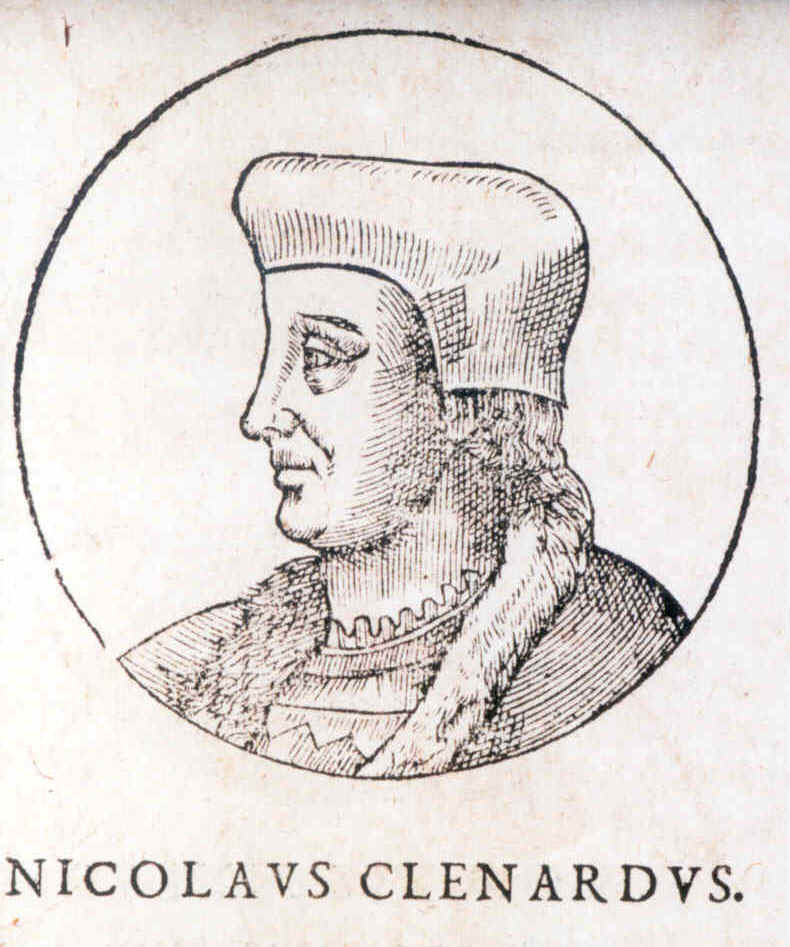Nicolas Cleynaerts on:
[Wikipedia]
[Google]
[Amazon]
 Nicolas Cleynaerts (Clenardus or Clenard) (5 December 1495 – 1542) was a
Nicolas Cleynaerts (Clenardus or Clenard) (5 December 1495 – 1542) was a
 Nicolas Cleynaerts (Clenardus or Clenard) (5 December 1495 – 1542) was a
Nicolas Cleynaerts (Clenardus or Clenard) (5 December 1495 – 1542) was a Flemish
Flemish (''Vlaams'') is a Low Franconian dialect cluster of the Dutch language. It is sometimes referred to as Flemish Dutch (), Belgian Dutch ( ), or Southern Dutch (). Flemish is native to Flanders, a historical region in northern Belgium; ...
grammarian and traveler. He was born in Diest
Diest () is a city and municipality located in the Belgian province of Flemish Brabant. Situated in the northeast of the Hageland region, Diest neighbours the provinces of Antwerp to its North, and Limburg to the East and is situated around ...
, in the Duchy of Brabant
The Duchy of Brabant was a State of the Holy Roman Empire established in 1183. It developed from the Landgraviate of Brabant and formed the heart of the historic Low Countries, part of the Burgundian Netherlands from 1430 and of the Habsburg Neth ...
.
Life
Cleynaerts was a follower of Jan Driedo. Educated at the University of Leuven, he became a professor of Latin, which he taught by the conversational method. A desire to read the ''Koran
The Quran (, ; Standard Arabic: , Quranic Arabic: , , 'the recitation'), also romanized Qur'an or Koran, is the central religious text of Islam, believed by Muslims to be a revelation from God. It is organized in 114 chapters (pl.: , si ...
'' led him to try to establish a connection between Hebrew and Arabic. These studies resulted in a scheme for proselytism
Proselytism () is the policy of attempting to convert people's religious or political beliefs. Proselytism is illegal in some countries.
Some draw distinctions between ''evangelism'' or '' Da‘wah'' and proselytism regarding proselytism as invol ...
among the Arabs, based on study of the language, which should enable Europeans to combat Islam by peaceful methods. In pursuit of this, he travelled to Spain in 1532, and after teaching Greek at Salamanca
Salamanca () is a city in western Spain and is the capital of the Province of Salamanca in the autonomous community of Castile and León. The city lies on several rolling hills by the Tormes River. Its Old City was declared a UNESCO World Herit ...
was summoned to the court of Portugal as tutor to Dom Henrique, brother of João III.
He found another patron in Louis Mendoza, marquis of Mondéjar, governor general
Governor-general (plural ''governors-general''), or governor general (plural ''governors general''), is the title of an office-holder. In the context of governors-general and former British colonies, governors-general are appointed as viceroy ...
of Granada. There with the help of a Moorish slave he gained a knowledge of Arabic. He tried in vain to gain access to the Arabic manuscripts in the possession of the Spanish Inquisition
The Tribunal of the Holy Office of the Inquisition ( es, Tribunal del Santo Oficio de la Inquisición), commonly known as the Spanish Inquisition ( es, Inquisición española), was established in 1478 by the Catholic Monarchs, King Ferdinand ...
, and finally, in 1540, set out for Africa to seek information for himself.
He reached Fez
Fez most often refers to:
* Fez (hat), a type of felt hat commonly worn in the Ottoman Empire
* Fez, Morocco (or Fes), the second largest city of Morocco
Fez or FEZ may also refer to:
Media
* ''Fez'' (Frank Stella), a 1964 painting by the moder ...
, then a flourishing seat of Arab learning, but after fifteen months of privation and suffering was obliged to return to Granada, and died in the autumn of 1542. He was buried in the Alhambra.
Works
Cleynaerts applied himself to the preparation of manuals of Greek andHebrew
Hebrew (; ; ) is a Northwest Semitic language of the Afroasiatic language family. Historically, it is one of the spoken languages of the Israelites and their longest-surviving descendants, the Jews and Samaritans. It was largely preserved ...
grammar
In linguistics, the grammar of a natural language is its set of structural constraints on speakers' or writers' composition of clauses, phrases, and words. The term can also refer to the study of such constraints, a field that includes domain ...
, in order to simplify the difficulties of learners. His ''Tabulae in grammaticen hebraeam'' (1529), ''Institutiones in linguam graecam'' (1530), and ''Meditationes graecanicae'' (1531) appeared at Leuven. The ''Institutiones'' and ''Meditationes'' passed through a number of editions, and had many commentators. He maintained a principle revived in modern teaching, that the learner should not be puzzled by elaborate rules until he has obtained a working acquaintance with the language.
References
*Notes
Further reading
* Latin letters to his friends in Flanders, ''Nicolai Clenardi, Peregrinationum ac de rebus machometicis epistolae elegantissimae'' (Leuven, 1550), and a more complete edition, ''Nic. Clenardi Epistolarum libri duo'' (Antwerp, 1566), from the house of Plantin; * Victor Chauvin and Alphonse Roersch, "Etude sur la vie et les travaux de Nicolas Clenard" in ''Mémoires couronnes'' (vol. lx., 1900–1901) of the Royal Academy of Belgium, which contains information on Cleynaerts and an extensive bibliography of his works. * "A Scholar and Traveller of the Renaissance", review of ''Nic. Clenardi Epistolarum libri duo'' in ''The Quarterly Review'' 1893, vol. 176, p. 140-165. 1495 births 1542 deaths 16th-century Latin-language writers Flemish Renaissance humanists Flemish writers (before 1830) Language teachers Lexicographers People from Diest Slave owners Grammarians of Hebrew Grammarians of Ancient Greek Old University of Leuven alumni French male non-fiction writers {{edu-bio-stub